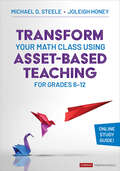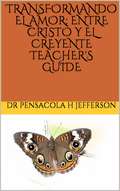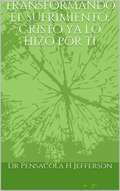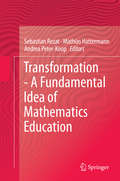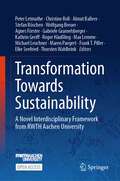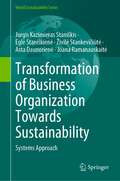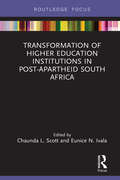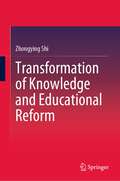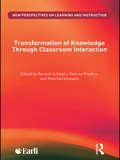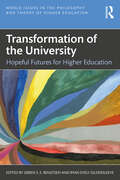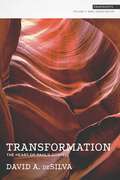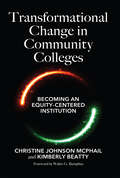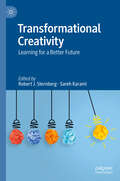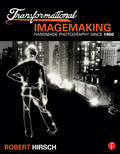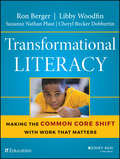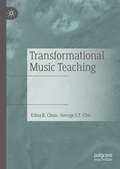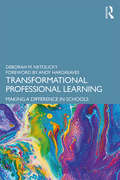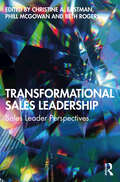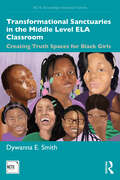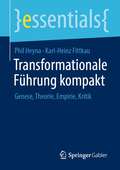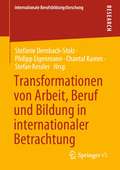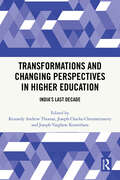- Table View
- List View
Transform Your Math Class Using Asset-Based Teaching for Grades 6-12 (Corwin Mathematics Series)
by Michael D. Steele Joleigh HoneyFoster a love of mathematics by creating a more inclusive and empowering learning environment through asset-based teaching! An asset-based perspective on math education means starting with what students already know instead of focusing on what’s missing. This approach elevates student thinking and reasoning skills. In this way, educators acknowledge that all students bring prior experiences, strengths, talents, and resources to the learning process and can contribute meaningfully in an authentic learning environment. Transform Your Math Class Using Asset-Based Teaching for Grades 6-12 provides insight into asset-based perspectives in mathematics education to create an environment where all students feel valued and capable of being doers of mathematics. In the book, Michael Steele and Joleigh Honey highlight the importance of using language, instructional routines, and systemic structure that positively impact student engagement, their math identity, and ultimately their outcomes. Providing a wealth of knowledge and practical strategies that can be used to transform math classrooms into inclusive, supportive, and empowering learning environments, this book: Introduces an asset-based perspective that focuses on students′ strengths, assets, and potential to learn mathematics Includes a variety of frameworks and tools that teachers can use to build and grow their sense of asset-based perspectives Offers strategies for promoting a growth mindset in mathematics, encouraging productive struggle in math, and promoting equitable math instruction Supports teachers in reflecting on their decisions, self-awareness, and self-management Includes a companion online study guide to support teachers individually or as part of a professional learning community Adopting asset-based perspectives is about movement over time, not about flipping a switch. This book paves the path for an asset-based journey that ultimately helps to transform our math classrooms and advance all students’ learning and development.
Transform Your Math Class Using Asset-Based Teaching for Grades 6-12 (Corwin Mathematics Series)
by Michael D. Steele Joleigh HoneyFoster a love of mathematics by creating a more inclusive and empowering learning environment through asset-based teaching! An asset-based perspective on math education means starting with what students already know instead of focusing on what’s missing. This approach elevates student thinking and reasoning skills. In this way, educators acknowledge that all students bring prior experiences, strengths, talents, and resources to the learning process and can contribute meaningfully in an authentic learning environment. Transform Your Math Class Using Asset-Based Teaching for Grades 6-12 provides insight into asset-based perspectives in mathematics education to create an environment where all students feel valued and capable of being doers of mathematics. In the book, Michael Steele and Joleigh Honey highlight the importance of using language, instructional routines, and systemic structure that positively impact student engagement, their math identity, and ultimately their outcomes. Providing a wealth of knowledge and practical strategies that can be used to transform math classrooms into inclusive, supportive, and empowering learning environments, this book: Introduces an asset-based perspective that focuses on students′ strengths, assets, and potential to learn mathematics Includes a variety of frameworks and tools that teachers can use to build and grow their sense of asset-based perspectives Offers strategies for promoting a growth mindset in mathematics, encouraging productive struggle in math, and promoting equitable math instruction Supports teachers in reflecting on their decisions, self-awareness, and self-management Includes a companion online study guide to support teachers individually or as part of a professional learning community Adopting asset-based perspectives is about movement over time, not about flipping a switch. This book paves the path for an asset-based journey that ultimately helps to transform our math classrooms and advance all students’ learning and development.
Transformando El amor: TRANSFORMANDO EL AMOR: ENTRE CRISTO Y EL CREYENTE TG
by DR Pensacola H JeffersonPara disfrutar verdaderamente el viaje cristiano, el creyente debe conocer la diferencia. Una relación no se trata de seguir un conjunto de reglas, sino de la reciprocidad entre personas unidas o en una unión con otra que implica amor genuino, compromiso, honestidad y fidelidad. "... te he amado con un amor eterno ..." (Jeremías 31: 3 NASB). “… Ciertamente, Él ama a la gente…” (Deuteronomio 33: 3 NASB). “… Dios ha dicho“ Nunca te dejaré; nunca te desampararé… ”(Hebreos 13: 5 NVI). "... Tu palabra es VERDAD (HONESTA) ..." (JUAN 17:17 RV). “… Permanece fiel [en sus relaciones de pacto], porque no puede negar quién es…” (2 Timoteo 2:13 NTV). La relación de “un solo espíritu” es una intimidad espiritual que solo puede ser entendida por revelación divina (a través del Espíritu Santo que mora en nosotros) y experimentada por fe (dependiendo del poder de su Palabra). “… POR FE (al depender de Dios, el Espíritu Santo que mora en nosotros) [tenemos el poder de] ... entender (o recibir conocimiento de revelación) que… lo que ahora vemos no provino de nada que pueda verse (la OBRA confirmadora del ESPÍRITU SANTO de Dios) ". (Hebreos 11 NLT). “… POR LA PALABRA (que activa la OBRA confirmadora del ESPÍRITU SANTO) del Señor [TODAS LAS COSAS VINIERON O LLEGARÁN A SER]…” (Salmos 33: 6 NASB). Tú, el creyente, estás "unido" a Dios a través de Jesucristo. Un cuerpo tiene muchas partes, pero solo cuando esas partes están unidas, forman un cuerpo. "... El amor ... es el VINCULO perfecto de unidad ..." (Colosenses 3:14 NASB). "Porque por un Espíritu, [somos] todos bautizados en un cuerpo ..." (1 Corintios 12:13). "... EL QUE ESTÁ UNIDO AL SEÑOR (Jesús, la Palabra de Dios) ES UN ESPÍRITU ... [con Dios otra vez] ..." (1 CORINTIOS 6:17 RV).
Transformando el sufrimiento: GUÍA PARA MAESTROS
by Dr Pensacola H JeffersonTransformando el sufrimiento: cristo ya lo hizo por ti. Este libro te dice cómo el sufrimiento demostrará qué o a quién amas "realmente". Satanás está listo y dispuesto a provocar los problemas que él cree que te pondrán en contra de Dios. Satanás le dijo a Dios acerca de Job: "...Pero extiende la mano y quítale todo lo que posee, ¡a ver si no te maldice en tu propia cara! "(JOB 1: 7-12 NVI). Sus acusaciones eran totalmente infundadas.
Transformation - A Fundamental Idea of Mathematics Education
by Sebastian Rezat Mathias Hattermann Andrea Peter-KoopThe diversity of research domains and theories in the field of mathematics education has been a permanent subject of discussions from the origins of the discipline up to the present. On the one hand the diversity is regarded as a resource for rich scientific development on the other hand it gives rise to the often repeated criticism of the discipline's lack of focus and identity. As one way of focusing on core issues of the discipline the book seeks to open up a discussion about fundamental ideas in the field of mathematics education that permeate different research domains and perspectives. The book addresses transformation as one fundamental idea in mathematics education and examines it from different perspectives. Transformations are related to knowledge, related to signs and representations of mathematics, related to concepts and ideas, and related to instruments for the learning of mathematics. The book seeks to answer the following questions: What do we know about transformations in the different domains? What kinds of transformations are crucial? How is transformation in each case conceptualized?
Transformation Towards Sustainability: A Novel Interdisciplinary Framework from RWTH Aachen University
by Gabriele Gramelsberger Peter Letmathe Frank T. Piller Roger Häußling Wolfgang Breuer Michael Leuchner Stefan Böschen Agnes Förster Elke Seefried Christine Roll Almut Balleer Kathrin Greiff Max Lemme Maren Paegert Thorsten WahlbrinkThe global environmental crisis, technological developments, the COVID-19 pandemic, and ongoing economic and political globalization are just a few of the developments that are massively increasing the pressure for transformation on regions, companies and society as a whole. In addition, the digital age is accelerating transformation processes that are already underway. This contributed book addresses these developments and presents a new framework for transformation research and practice that has been developed and already validated by researchers of the RWTH Aachen University. The RWTH way includes inter- and transdisciplinary approaches from many disciplines, looking at technological and societal change from different perspectives. A distinction is made between analysis, i.e., research on transformation processes, impact, i.e., transformational research, and change in research itself, i.e. research transformation. The book not only creates a new understanding of transformation research, but also provides actionable impulses for scholars and practitioners in many fields. This is an open access book.
Transformation and Empowerment through Education: Reconstructing our Relationship with Education
by Raqib ChowdhuryTransformation and Empowerment through Education challenges the normalisation of Western discourses as the optimal choice for empowering education. The book aims to reconstruct our relationship with education and employs contemporary theories in order to understand some of the most persistent phenomena in contemporary education and its role in our lives. Written by professionals with experience of a wide range of academic and institutional conventions and traditions, and from diverse ethnocultural backgrounds, this book effectively presents a global perspective on educational practices, both inside and outside the classroom. The range of topics covered includes equity, access, inclusivity, social justice, leadership and the internationalisation of teaching. This book, based on empirical studies using key methodologies, is ideal for academics and postgraduate researchers interested in critical pedagogy, educational studies and educational linguistics, as well as educators and policymakers around the world.
Transformation of Business Organization Towards Sustainability: Systems Approach (World Sustainability Series)
by Asta Daunorienė Jurgis Kazimieras Staniškis Eglė Staniškienė Živilė Stankevičiūtė Joana RamanauskaitėWe have entered a new era where business, technologies, communities, and even pandemic deceases cross borders with unprecedented speed and intensity. 2030 Agenda and 17 SDGs reflect the global community's high expectations of finally reversing the destruction of our natural and social habits, and achieving a more balanced and equitable pathways toward well-being of all. However, despite the initial efforts, the world is not on track to achieving the most of the 169 targets that comprise the goals. It is evident that we have a system problem, so we need a system solution. Authors presented a hierarchical system consisting of two-level management systems: first level—unsustainability reduction systems and second level—control system for transformations toward sustainability. The book clearly shows that implementation of systems for unsustainability reduction and for transformations toward sustainability is possible, and that sufficient knowledge is available to get started. It is designed for researchers, practitioners, and politicians.
Transformation of Higher Education Institutions in Post-Apartheid South Africa
by Chaunda L. Scott Eunice N. IvalaThis book outlines successful transformation strategies and efforts that have been developed to assist the South African higher education system in moving beyond its post-apartheid state of being. Through case studies authored by South African higher education scholars and scholars affiliated with South African institutions, this book aims to highlight the status of transformation in the South African higher education system; demonstrate the variety of transformation initiatives used in academic institutions across South Africa; and offer recommendations to further advance this transformation. Written for scholars and advanced students of higher education in international settings, this volume aims to support quality research that benefits the demographic composition of South African academics and students, and offers lessons that can inform higher education transformation in similarly multicultural societies.
Transformation of Knowledge and Educational Reform
by Zhongying ShiThis book defines the concept of knowledge transformation, describes the historical process of knowledge transformation, and analyses its deep influence on education theory and practice by virtue of multiple discipline resources. The general scope of this book encompasses the philosophy of education, curriculum studies, and education reform research. It enables readers to understand how 'hidden' epistemological factors have changed or reshaped the education system throughout history and at present.
Transformation of Knowledge through Classroom Interaction (New Perspectives on Learning and Instruction)
by Tommy Dreyfus Baruch Schwarz Rina HershkowitzClassrooms provide extremely varied settings in which learning may take place, including teacher-led conversations, small group unguided discussions, individual problem solving or computer supported collaborative learning (CSCL). Transformation of Knowledge through Classroom Interaction examines and evaluates different ways which have been used to support students learning in classrooms, using mathematics and science as a model to examine how different types of interactions contribute to students’ participation in classroom activity, and their understanding of concepts and their practical applications. The contributions in this book offer rich descriptions and ways of understanding how learning occurs in both traditional and non-traditional settings. Combining theoretical perspectives with practical applications, the book includes discussions of: the roles of dialogue and argumentation in constructing knowledge the role of guidance in constructing knowledge abstracting processes in mathematics and science classrooms the effect of environment, media and technology on learning processes methodologies for tracing transformation of knowledge in classroom interaction. Bringing together a broad range of contributions from leading international researchers, this book makes an important contribution to the field of classroom learning, and will appeal to all those engaged in academic research in education.
Transformation of the University: Hopeful Futures for Higher Education (World Issues in the Philosophy and Theory of Higher Education)
by Søren S. E. BengtsenTransformation of the University imagines preferable futures for the university, building hope for the institution’s necessary transformation. It transcends old criticisms and presents fresh ideas on how the institution might be conceived, organised and put into practice while safeguarding that which makes it a university – the pursuit of knowledge. This book is divided into three main parts: Part One – ‘Knowledge’ assumes the role of the university in generating knowledge for the benefit of society; Part Two – ‘Cultural Growth’ expands on how the university might contribute to and benefit from the cultural growth of society, with both explicit and implicit connections to social and epistemic (in)justice; and Part Three – ‘Institutions’ focuses on imaginative processes for enacting the university as an institution that meets the unforeseen future challenges facing societies around the world. With contributions from scholars across the world, Transformation of the University is an essential read for all academics, practitioners, institutional leaders and broad social thinkers who are concerned with the future of the university and its contributions to society.
Transformation: The Heart of Paul's Gospel (Snapshots)
by David A. DeSilvaThe gospel is often presented as little more than a "get out of hell free" pass. But is that all there is to it? What made it so compelling that the Apostle Paul would give up everything, enduring hardships and deprivation to preach good news? David deSilva argues that some Christians have unintentionally reduced the gospel to a message Paul would hardly recognize. The "gift of righteousness" is far richer than many of us have dared to imagine! In Transformation: The Heart of Paul's Gospel, deSilva examines the gospel message as presented in Paul's letters. He demonstrates that Paul had nothing less than in mind than the means to transform and renew all of creation--including ourselves. Prepare to let Paul's message of change and renewal transform your own thinking.
Transformational Change in Community Colleges: Becoming an Equity-Centered Institution
by Christine Johnson McPhail Kimberly BeattyFrom the foreword by Walter G. Bumphus, President & CEO of AACC: “Becoming an Equity-Centered Higher Education Institution is a significant contribution to the on-going struggle to find practical approaches to implementing an equity agenda in higher education.” The authors had three main goals for this text: Relevance: This book is the result of many years of teaching, leading, researching, and coaching individuals and institutions about equity inside higher education. The authors place a clear emphasis on awareness and teaching skills first, but also ensure that those skills are based on practical application in the field. Practical Application: To describe and explain equity and transformational change concepts, this book provides step-by-step implementation approaches that can be used to integrate equity-centered principles into practices and policies to implement or improve equity work into the organizational culture. A Purposeful Approach: The authors defined the act of becoming an equity-centered institution in terms of a transformational change approach using Kotter’s Eight-Stage Process. Kotter’s Model and AACC’s Leadership Competencies for Community College Leaders are introduced in Chapter 1 and integrated throughout the book. This integrated framework allows practitioners to place the intersectionality of equity, transformational change, and requisite leadership competencies into the larger context of higher education. While using Kotter’s 8-Step Change Model, the authors emphasize that operations and situations inside higher educational institutions are not linear as implied in Kotter’s model. They show how the stages of change may occur at different times and different situations at different institutions, and demonstrate what leadership competencies are recommended for each stage in the change process.
Transformational Creativity: Learning for a Better Future
by Robert J. Sternberg Sareh KaramiThis edited volume brings together leading scholars in diverse disciplines to share their best thinking on how creativity can be conceived of, taught for, and deployed to serve rather than undermine humanity. Transformational creativity, as defined in this book, is creativity deployed to make a positive, meaningful, and potentially enduring difference to the world. Transformational creativity is compared to transactional creativity, which is creativity deployed in search of a reward, whether externally or internally generated.
Transformational Imagemaking: Homemade Photography Since 1960
by Robert HirschThis groundbreaking survey of significant work and ideas focuses on imagemakers who have pushed beyond the boundaries of photography as a window on our material world. Through interviews with more than 40 key artists, this book explores a diverse group of curious experimentalists who have propelled the medium’s evolution by visualizing their subject matter as it originates from their mind’s eye. Many favor the historical techniques commonly known as alternative photographic processes, but all these makers demonstrate that the real alternative is found in their mental approach and not in their use of physical methods. Within this context, photographer and photography historian Robert Hirsch outlines the varied approaches these artists have utilized to question conventional photographic practices, to convey internal realities, and to examine what constitutes photographic reality. Hirsch explores the half-century evolution of these concepts and methodologies and their popularity among contemporary imagemakers who are merging digital and analog processes to express what was thought to be photographically inexpressible. Read an interview with the author at Photo.net: http://photo.net/learn/photographer-interviews/robert-hirsch
Transformational Leadership & Decision Making in Schools
by Robert E. Brower Dr Bradley V. BalchHelps school leaders re-center their decision making on student achievement, mission, and goal alignment. Covers self-assessment, reflective thinking, vision and mission, motivation, and barriers to decision making.
Transformational Literacy: Making the Common Core Shift with Work That Matters
by Ron Berger Libby Woodfin Cheryl Becker Dobbertin Suzanne Nathan PlautEngage, challenge, and inspire students with work that matters Transformational Literacy, written by a team from Expeditionary Learning, helps teachers leverage the Common Core instructional shifts--building knowledge through content-rich nonfiction, reading for and writing with evidence, and regular practice with complex text--to engage students in work that matters. Worthy texts and worthy tasks help students see the connection between their hard work as readers and writers and their capacity to contribute to stronger communities and a better world. The stories, examples, and resources that permeate Transformational Literacy come primarily from the more than 150 Expeditionary Learning schools around the country that support teachers to select, supplement, customize, and create curriculum, and improve instruction. The book also draws on Expeditionary Learning's open source Common Core English Language Arts curriculum--often cited as one of the finest in the country--and professional development offered to thousands of teachers to implement that curriculum effectively. Transformational Literacy combines the best of what Expeditionary Learning knows works for kids--purposeful, inquiry-based learning--and the new imperative of the Common Core--higher and deeper expectations for all students. Teach standards through a compelling and purposeful curriculum that prioritizes worthy texts and worthy task Improve students' evidence-based reading, thinking, talking, and writing Support students to develop a new mindset toward the challenge of reading complex texts Transformational Literacy introduces an approach to literacy instruction that will engage, challenge, and inspire student with work that matters.
Transformational Music Teaching
by Edna B. Chun George S.T. ChuDesigned as a practical resource, this book examines transformational and inclusive approaches to the teaching of music at the postsecondary level based on first-person interviews with renowned musicians and their students. At the heart of the study are musical/artistic perspectives and pedagogical approaches from leading artists and the insights of their students on the impact of the teaching and mentoring process. Through case studies with renowned musicians and their protégés, the book identifies common themes in teaching and mentoring across classical and jazz performance. Each case study is a master class with the artist that offers insight into the evolution of the individual’s musical career, their approach to teaching, and specific strategies for navigating the complexities of the music business environment. With remarkable candor, artists and their protégés share how they navigated significant obstacles in their career journeys. Including overcoming performance anxiety, disability and injury, lack of financial support, difficulty obtaining an agent and recording contracts, country location and stereotypes based on gender and nationality. The book serves as an important resource for music educators by offering concrete approaches to mentoring talented students, while also sharing specific strategies for aspiring professional musicians seeking to forge a career in a highly competitive musical market.
Transformational Professional Learning: Making a Difference in Schools
by Deborah M. NetolickyEmerging from an education world that sees professional learning as a tool to positively shape teaching practice in order to improve student learning, Transformational Professional Learning elucidates professional learning that is transformational for teachers, school leaders, and schools. Written from the unique ‘pracademic’ perspective of an author who is herself a practising teacher, school leader, and researcher, this book articulates the why and the what of professional learning. It acts as a bridge between research and practice by weaving scholarly literature together with the lived experience of the author and with the voices of those working in schools. It covers topics from conferences, coaching, and collaboration, to teacher standards and leadership of professional learning. This book questions the ways in which professional learning is often wielded in educational settings and shows where teachers, school leaders, system leaders, and researchers can best invest their time and resources in order to support and develop the individuals, teams, and cultures in schools. It will be of great interest to teachers, leaders within schools, staff responsible for professional learning in school contexts, professional learning consultants, professional learning providers, and education researchers.
Transformational Sales Leadership: Sales Leader Perspectives
by Beth Rogers Christine A. Eastman Phill McGowanTransformational Sales Leadership: Sales Leader Perspectives offers viewpoints from 12 leaders across the global sales industry, all of which challenge conventional sales models and promote visionary ways of thinking about sales and leadership.The leaders who share their professional stories in the book are from organizations including SAP, Google, Nationwide US, and Royal Caribbean, as well as their own practices, and they represent a new breed of salespeople who are increasingly sought after by organizations which need to transform their practices. They run teams, drive analytics, and improve operational excellence, and their careers rise or fall on getting the right KPIs. Their stories address solutions to age-old sales problems, but they bring a new perspective to the sales function in the digital age. The book focuses on what sales leaders need in order to be innovative. Specifically, the book shows you how to:• Coach sales people through disruption;• Leverage the most valuable habits for success; and• Provide for meaning and purpose in the hyper-connected and volatile sales industry.If you are a sales professional looking to succeed in challenging scenarios, the journeys recounted in this book demonstrate how the landscape of sales has changed and how thinking about sales differently can help you transform your career.
Transformational Sanctuaries in the Middle Level ELA Classroom: Creating Truth Spaces for Black Girls (NCTE-Routledge Research Series)
by Dywanna E. SmithDrawing from an arts-based research and humanizing methodologies, Dywanna Smith documents transformative and liberatory spaces in ELA middle level classrooms, where students address and counteract discrimination, colorism, sizism, and body shaming. Grounded in an original qualitative study of adolescent Black girls, this book examines how such "truth spaces" serve as a medium for adolescents to self-examine their intersectional identities and give voice to their resilience in the face of marginalization. Incorporating original narratives, including the author’s self-actualizing verse novel and the voices of Black female students, Smith shines a light on new culturally sustaining pedagogies and offers much-needed implications for practice. Smith expertly weaves together poetry, research, and empathy; the result is a pioneering text that urges readers to understand the impact of anti-Black violence and the important role literacy sanctuaries can play in supporting Black girls’ resilience and development. The novel in verse at the heart of the volume is not only a provocative and necessary call for transformative change, but also a window into a courageous lived experience. This book is essential reading for pre-service teachers, scholars, and students in literacy education, inclusive education, and teacher education.
Transformationale Führung kompakt: Genese, Theorie, Empirie, Kritik (essentials)
by Karl-Heinz Fittkau Phil HeynaSeit den frühen 1980er Jahren hat keine andere Theorie in der Führungsforschung mehr Aufmerksamkeit erfahren als die transformationale Führung. Ebenso wird deutlich, dass die Auseinandersetzung mit dieser bis heute unvermindert andauert und sie die jüngere Führungsforschung nachhaltig geprägt hat. Bei näherer Betrachtung wird ersichtlich, dass insbesondere das theoretische Modell von Bernard M. Bass auf eine hohe Resonanz gestoßen ist. Aus diesem Grund wird dieses Modell dargestellt, einschließlich dessen Genese, Theorie, Messbarkeit, Lehr- und Lernbarkeit, Empirie und Kritik.
Transformationen von Arbeit, Beruf und Bildung in internationaler Betrachtung (Internationale Berufsbildungsforschung)
by Philipp Eigenmann Chantal Kamm Stefanie Dernbach-Stolz Stefan KesslerDer Begriff des Berufs verschränkt die unterschiedlichen Ansprüche, Zielsetzungen und Logiken zweier Welten – einer Welt der Arbeit und einer Welt der Bildung. Gerade im deutschen Sprachraum sind Berufskonzepte für die Ausrichtung einer arbeitsmarktbezogenen (Aus-)Bildung prägend. Diese Beziehung kann jedoch global betrachtet in sehr unterschiedlichen Formen beobachtet werden. Auch unterliegt sie einem permanenten Wandel. Die Beiträge des Bandes knüpfen daran an, um in international vergleichender und historischer Perspektive Transformationen der Verbindung von Arbeit, Bildung und Beruf sowie deren Interdependenzen auszuloten.
Transformations and Changing Perspectives in Higher Education: India's Last Decade
by Joseph Varghese Kureethara Kennedy Andrew Thomas Joseph Chacko ChennattuserryThis book reveals the intricacies of the Indian education system, especially those that surged in the past decade. It covers several perspectives of global higher education, wherein the dynamic trends and frameworks are explicated for a better understanding of the curriculum design and delivery of higher education in India. It facilitates students’ learning and experiences, wherein the post-pandemic insights for learning from remote locations could be gleaned.This volume looks at the complexities in the functioning of educational institutions and suggests novel approaches and interventions that are crucial for the educational framework of India. It attempts to draw theoretical implications of the educational system and uses empirical evidence for recommending actionable processes.As a multidisciplinary work covering international policies and global perspectives on higher education, this book would be useful to students, teachers of education, political science, public administration, international relations, economics, psychology, cognitive science, life skills education, counselling, sociology, gender studies, social work, performing arts, and disaster management. It will also be an indispensable resource for researchers, academicians, professionals, government and policy makers of the country and the world at large.
